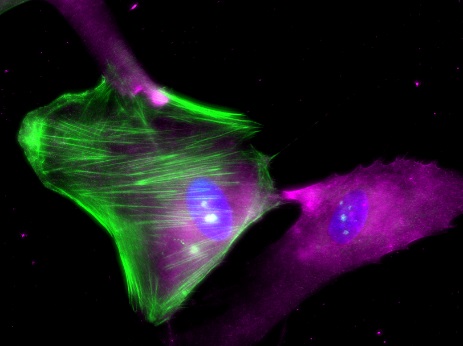Research

Cell therapies for diabetic retinopathy
Diabetic retinopathy (DR) is the most frequently occurring microvascular complication of diabetes often resulting in severe vision loss or blindness. One possible novel therapeutic route is to target the early vasodegenerative stages of DR, enhancing vessel repair to regain adequate retinal perfusion. A PhD student in my group, Jessica Eyre, is investigating the potential use of circulating endothelial progenitor cells (EPCs) as a cell source to enhance vessel repair. Working in collaboration with Rachel Williams she will use functional polymers to optimise EPC expansion in vitro and also develop a diabetic in vitro model of human retinal endothelial cells and pericytes to investigate the incorporation of the EPCs.

Tissue engineering the cornea
The integrity and transparency of the cornea are essential for proper functioning of the eye. Corneal blindness affects over 10 million people worldwide and current treatment strategies often involve replacement of the defective tissue layer with donor tissue. The issue with this is that there is a worldwide shortage of donor corneas. One of my areas of interest is the development of corneal biosynthetic alternatives for transplantation. This includes the 3 major cellular layers of the cornea; epithelium, stroma and endothelium. A PhD project in collaboration with Dr Elizabeth Laird and Dr Victoria Kearns aims to develop a bioengineered corneal stroma for transplantation.Danielle O’Loughlin is testing suitable cell sources and methods of alignment and stratification in order to create the optimal transparent, biomimetic stromal tissue.
The corneal endothelium in health and disease
The corneal endothelium is a single layer of cells lining the back of the cornea. These cells are essential to keep the cornea transparent and maintain vision. Failure of the corneal endothelium leads to marked clouding of the cornea and loss of vision. Over 3000 corneal transplants are performed annually in the UK and conditions resulting in failure of the corneal endothelium account for up to 60% of corneal transplants. Historically, the corneal endothelium was thought to be a non-replicating layer. However, recent evidence suggests that the peripheral endothelium may harbour endothelial progenitor cells capable of replication and potentially repair. I am interested in exploring this possible progenitor niche to exploit its physical and cellular characteristics to create biomimetic tissue equivalents. Another focus of my research is to investigate why corneal endothelial grafts fail and the development of strategies to improve not only the graft but the transplant microenvironment to increase survival.
Research grants
Corneal epithelial cell transfer to treat persistent epithelial defect
MEDICAL RESEARCH COUNCIL
May 2024 - September 2027
Rami Rasheed Alanazi - Bench fees (201606338)
ROYAL EMBASSY OF SAUDI ARABIA CULTURAL BUREAU IN LONDON (UK)
May 2023 - April 2027
Bio-synthetic corneal endothelial grafts for transplantation
MEDICAL RESEARCH COUNCIL
January 2022 - July 2025
Assessing the therapeutic potential of circulating endothelial progenitor cells for treatment of diabetic retinopathy
DIABETES UK (UK)
December 2019 - May 2021
Research Eye Bank Project
FOUNDATION FOR THE PREVENTION OF BLINDNESS (UK)
September 2012 - July 2017
IPE stem cells for the treatment of retinal diseases
JAMES KENT TRUST (UK)
October 2017 - December 2022
Creation of bio-synthetic corneal endothelial grafts for transplantation using novel peptide gels
FIGHT FOR SIGHT (UK)
October 2017 - December 2019
Effect of corneal preservation medium on donor corneas for pre-loading Descemet Membrane Endothelial Keratoplasty
FIGHT FOR SIGHT (UK)
December 2016 - June 2018
Research Eye Bank
FOUNDATION FOR THE PREVENTION OF BLINDNESS (UK)
January 2017 - June 2018
Peptide gels for corneal endothelial transplantation
MEDICAL RESEARCH COUNCIL
April 2017 - March 2018
Research collaborations
Rachel Williams
Engineering for Growth
Building advanced materials to treat vision loss
Victoria Kearns
Bioengineering the corneal stroma
Joint PhD Studentship
Elizabeth Laird
Bioengineering the corneal stroma
Joint PhD Studentship